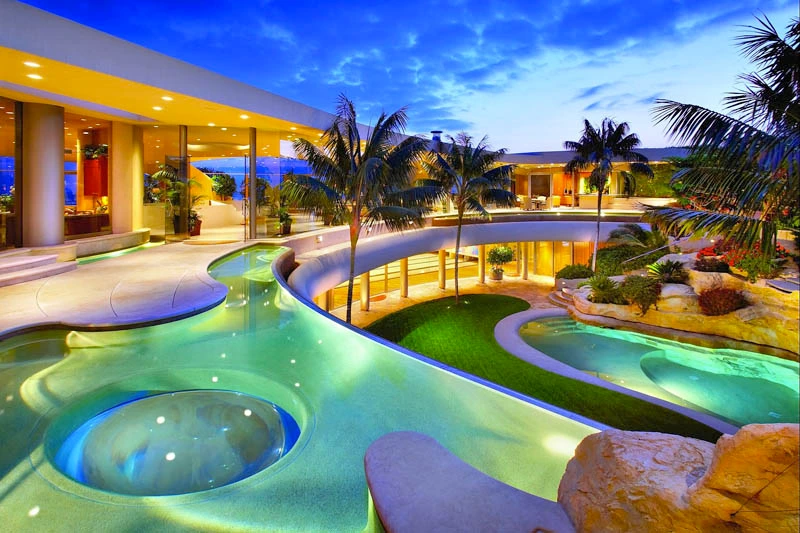WONDER WHY YOUR POOL HAS HIGH CYANURIC ACID (CYA) LEVELS?
How to maintain, lower, & raise CYA levels!?!?!
What is Cyanuric Acid (CYA) and Why do we care about the level of it in your swimming pool:
Cyanuric Acid is a chemical compound commonly used in many industries including the manufacturing of pool chemicals. Cyanuric Acid is a chemical commonly and easily referred to as CYA. Manufacturers of pool chemicals use Cyanuric Acid as a stabilizer in many chlorine and shock products. Stabilizer is the protector of chlorine, think of it like sunscreen for your chlorine tablets. Without the protection of CYA in your chlorine tablets they would quickly dissolve and not allow slow release of chlorine in your pool to keep it healthy and sanitized. The job of chlorine job is to sanitize your pool, but if it burns off too fast because of the sun then it cannot do its job.
Aloha Desert Pools is your local pool cleaning and repair company, we are a small family owned business based in Gilbert, Arizona, cleaning and repairing pools throughout the East Valley! Please keep in mind some of this may differ in different parts AZ and the rest of the Country or World! Also depending on your pool surface material, how old it is, the water source of fresh water going in your pool, how often your pool is used and many other factors.
I am going to try and give a few analogies to give you context because you may see your CYA levels go up over time in your pool. I will also give you some ways to help prevent this from happening, how to lower your Cyanuric Acid levels in your pool and other products that help!
The first analogy is that your pool is an enclosed system similar to a fish tank. What I mean by this is the water that is in there, is in there. 😊 Sure, we lose some water to evaporation (more certain times of the year) and we drain some out if you have a pool filter with a backwash, such as a Sand Filter or DE Filter. So if you have ever had a pet fish, even with the best chemical treatments & cleaning over time the water goes “bad” and needs to be replaced. In Gilbert, AZ and surrounding areas such as Mesa, Chandler, Queen Creek and Tempe it is common to have to drain your pool every 2-5 years! We have customers in Scottsdale and Gold Canyon that have very hard (high calcium) from the tap, so although this isn’t building the CYA it is contributing factor to needing to drain your pool, We can discuss other factors in another article or get in touch and we can talk about your specific swimming pool chemistry and needs. All of these factors are true no matter if you care for your pool yourself or have a professional pool company doing it!
You may hear more about CYA levels and pool draining in the winter, that is because it gets ridiculously hot in Arizona! Draining your pool is always a risk because pools are built to have water, so when you empty them you expose them to the sun, air, dirt under the pool may have settled or expanded in ways we will never know. So, when you drain your pool by yourself or with a pool company, you the customer does have to consider your risk and liability when you empty your pool. This is even a bigger risk as temperatures rise. We spend a lot of time bringing awareness to our customers between October and March to get their swimming pool drained water changed so we can do our best to avoid the Arizona sun, like the slogan, Valley of the Sun!
When temps are high, it can cause cracking and damage to your pool if it is not full of water. So, if you are trying to hit the reset button on your water and get some fresh water in your pool it is best to do it between October – March! If you live in Mesa, Tempe, Chandler, Ahwatukee, Gilbert, Queen Creek, Gold Canyon, Apache Junction, Scottsdale, Phoenix you know that summer temps can come early and stay late, so keep an eye on the forecast and we will plan your drain around the temps!
Whoever is maintaining your pool now or in the past did NOT cause the CYA levels to raise. When the temps rise, so do your water temperatures. This combination is a recipe for a lot of pool chemicals. A lot of pool chemicals like chlorine and shock are going to add to your CYA level, because the pool water stays in the pool, this will build over time. So, don’t get rid of a pool company because of this, get rid of a pool company that is not making you aware this is part of owning a pool. Even newer pools need to be drained to properly maintain the overall health of your pool water. This is not just us saying it, take a water sample to any pool supply store and get it tested for FREE! If you are maintaining your pool by yourself, get your water tested 1 timer per month in the cooler months and every week during the hotter months.
How to reduce the amount of Cyanuric Acid going into your pool?
The most common way to do this is to install or utilize your Saltwater Pool System! We can install a salt system onto an existing pool or make sure your salt cell is working properly. Want to know more about saltwater pools, click here!
If you have a DE or Sand Filter, they have a backwash valve! It can help if you backwash more often and for a longer period of time as this will slowly get rid of bad water and allow fresh water to fill in. If you have an area that you can safely backwash your pool down several inches at a time, this is a great way to reduce and maintain a normal level of Cyanuric Acid (CYA).
Use non-stabilized chlorine! Your options are limited to a non-stabilized chlorine tablet which is more expensive, work best with a special feeder that can cost almost as much as a saltwater system and can cause higher pH and Alkalinity and other things to balance. DO NOT MIX non-stabilized chlorine and stabilized chlorine. It can be extremely dangerous and cause explosions. Talk to your pool cleaner, local pool store or give us a ring, we are your pool company near you!
Another option is liquid chlorine! The challenge in the Valley of the Sun, is the SUN! If you want to use liquid chlorine you would need to have a constant drip of it going into your pool so that it can stay chlorinated! Remember, if is not stabilized with Cyanuric Acid, then it doesn’t have any protection against the sun! Liquid Chlorine can also be dangerous to store at your house and specially if you have a large amount of it. We do not recommend storing it. There are liquid chlorine dispensers that can look at your existing pool equipment and pool needs and see if this is a good fit.
There are products on the market that say “Use this chemical and reduce your Cyanuric Acid (CYA) Levels today! Do they work? Well, that is a yes and no answer! Yes, they will work if they are used often and correctly! They can be awfully expensive if you use it as directed on the manufactures label. If you don’t use the recommended amount you will say it doesn’t work. Keep in mind, if you are battling high CYA, you are also most likely dealing with older water that needs to be changed eventually! These CYA reducers are great when it is 110 degrees and you are battling a green pool. When the temps are way too hot to safely drain your pool, and we are having to put in so much chlorine, these products may be the only option! That is exactly how we would classify these Cyanuric Acid reducing chemicals, Last Resort and temporary. If you use a Cyanuric Acid Reducer successfully and get through summer, please know that you should drain your pool when the phoenix summer is over and get your pool filled with fresh water! Can’t hurt to also consider a chlorine bath, acid wash or pool tile cleaning too!
Ok, so if you are still reading this, you are probably wondering why we even care about Cyanuric Acid Levels, right?
Well, the reason we care about it so much is that when it gets too high, it makes it exceedingly difficult for chlorine to do its job, which is sanitize your pool! So high CYA means normal levels of chlorine will become ineffective and your pool can turn green even with balanced Chlorine, pH and Alkalinity! Some people refer to this as “chlorine lock”. Also, if your pool has high CYA levels and your chlorine levels are in normal range or even slightly higher range and you are still seeing algae there is a good chance the Cyanuric Acid levels in the pool are preventing the chlorine to do its job and kill algae and bacteria! You will have to put in a TON of chlorine, really raise the levels to battle this and have enough chlorine to turn it clear again! If we turn your pool from green to clear without draining it, you should prepare to drain your pool and get a chlorine wash or acid wash when the weather permits!
Field chemical test can vary slightly week to week, depending on sun light and many other factors. The best and most accurate test is from your local pool supply store. Even as a pool cleaning and repair company, when the chemistry of a pool is out of whack, we will take it in for a detailed water analysis. Local pool supply stores will test your water for FREE, but don’t fall for the up sale! Sometimes it is cheaper and better in the long run to just get fresh water in your pool.
There are a TON of products and chemicals on the market, and some don’t play well with others and can be extremely dangers. DO NOT MIX CHEMICALS. If we are professionally maintaining your pool, make sure to talk with us before you add anything else to your pool. Before you add any new chemicals to your pool make sure to talk to a pool professional.
You can follow Aloha Desert Pools on Facebook and Instagram!
If you have any questions about what you read in this article or anything pool related, please get in touch with us! No matter what part of the East Valley, AZ you live in, we are always your Pool Company near YOU! You can call or text 480-625-8794 or drop us an email at [email protected]




